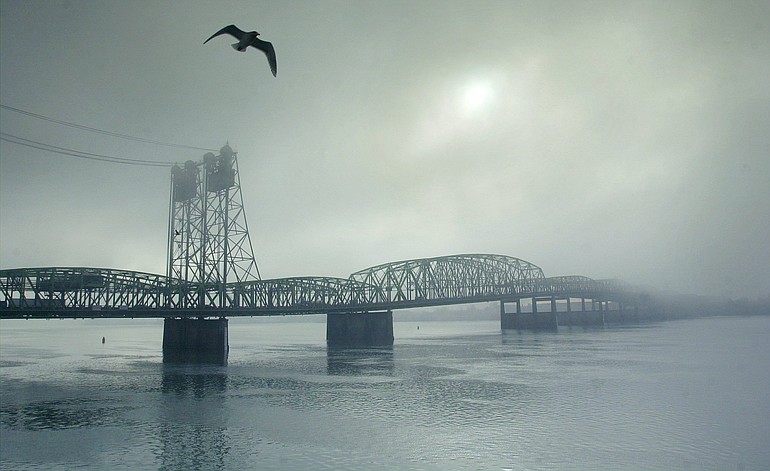It’s getting a lot tougher to sell a massive transportation project.
Vice President Richard Nixon could use the threat of atomic war to win approval for an interstate freeway system.
An Alabama senator could argue that better roads in an agricultural region would mean prosperous farms, which would keep farm lads from falling into sin in America’s urban fleshpots.
So how do you generate support for a monumental piece of infrastructure these days?
You can make claims for better efficiency, discuss increased demand and look ahead to the needs of future generations.
But you’d better be ready to answer a couple of questions: Who pays for it and who benefits from it?
Those were among the topics touched by six panelists Saturday during a discussion of the Columbia River Crossing project at the Clark County Historical Museum.
Three university faculty members, two agency officials and a former elected official all offered their perspectives on a new Interstate 5 bridge over the Columbia River.
The academic side was represented by Portland State University’s Vivek Shandas, an urban planner, and two Washington State University Vancouver faculty members, historical geographer Jorge Lizárraga and historian Steve Fountain.
Public policy perspective came from Jeff Hamm, C-Tran’s CEO and executive director; newly named Columbia River Crossing Co-director Nancy Boyd; and Robert Liberty, who recently left the Portland-area governing Metro Council to direct the University of Oregon’s Sustainable Cities Initiative.
I-5 crosses the Columbia River on two spans built about 50 years apart, during eras that are gone forever, Fountain said.
The 1917 span was a product of an era when highways were overseen by the Department of Agriculture, he said. And almost 100 years ago in Vancouver, the bridge “was a way for a farming county to connect with a major market,” Fountain said.
The second bridge span resulted from the national transportation expansion following World War II, when President Dwight Eisenhower promoted the interstate freeway system. Ike had been inspired by the autobahn system he used in Germany while leading the Allies to victory in WWII.
Eisenhower sent Vice President Richard Nixon to pitch the notion at a national governors’ conference, and it took some talking.
The governors ho-hummed highway traffic jams, congested transportation systems and even the high accident rate. Collisions at highway intersections killed a lot of people, and traffic accidents led to so many lawsuits that justice officials almost created a separate court system to handle them, Fountain said.
The governors’ response was pretty much, “Not our problem,” Fountain said. Then Nixon played the national-security card: An interstate freeway system would be indispensable if the U.S. was involved in an atomic war.
Lizárraga, the WSU Vancouver geographer, noted some interesting relationships involving the Columbia River Crossing: The project focuses on a 5-mile span of I-5, but it is a crucial link in a highway from Canada to Mexico. The bridge serves an metropolitan population of about 2.3 million people — about 60 percent of them living in Oregon — but is used primarily by Washington commuters.
Shandas, the Portland State University urban planner, said a recent trip to China showed him how areas along new roadways get developed. That’s something land-use planners will have to consider, including health and environmental implications.
Boyd, recently named by the state Department of Transportation to represent Washington in the bistate co-directorship of the Columbia River Crossing project, said planners are trying to make decisions that will hold up for 100 years. That sort of challenge is illustrated by an earlier generation of planners. The people who drew up the original bridge a century ago had to factor horses and wagons into their plans, she said.
Liberty opened his segment by predicting that a new span won’t be built. He offered some financial and political reasons that he believes will sink the project and also suggested cheaper and easier solutions for traffic issues.
Develop pull-out areas to accommodate cars involved in fender-bender accidents. Build a supplemental bridge from Portland to Hayden Island, keeping local traffic off I-5. If you want to speed up long-haul truck traffic, improve the roads in other parts of Oregon, he suggested.
Finally, Liberty said, the money just isn’t there for a bridge replacement. Washington’s roadway priorities are in the Seattle and Spokane areas. Oregon has already allocated its transportation funding, so financing a new I-5 bridge would mean pulling money from other projects.
And any funding questions ultimately will come down to this, Liberty said: Who pays, and who benefits?
Hamm, executive director and CEO of C-Tran, said the current issues might be new, but the impact on public transportation is, literally, an old story. Hamm said he took a look through a file of newspaper transit stories in Clark County and Vancouver. The file went back to 1937, Hamm said, and just about every story told of a system under stress.
The discussion was moderated by Superior Court Judge Barbara Johnson.
The panel discussion was held in conjunction with the museum’s exhibit “Bridging the Gap: The History of the Interstate Bridge,” which runs through October.
Tom Vogt: 360-735-4558 or tom.vogt@columbian.com.




